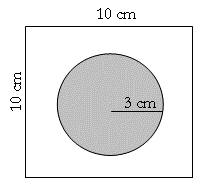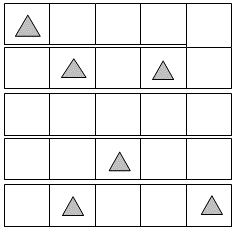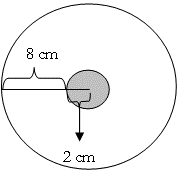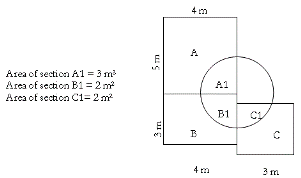Introduction
In the Target
Moon mission NASA will need to
determine the likelihood of a comet
hitting three lunar settlements.
NASA must find the probability that
the settlements will be hit by the
comet to decide whether the
astronauts and resources at each
site should be evacuated.
Probability is the likelihood that a
certain outcome will take place.
Probability is calculated by
creating a ratio of the number of
ways an event can happen to the
total number of possible outcomes
and can be shown as a fraction,
decimal, or percentage.
Duration
30-45 minutes
Vocabulary
outcomes:
possible results in a situation.
event: the
particular outcome that you are
looking for.
probability: a
ratio of the number of ways an event
can happen to the total number of
possible outcomes.
Pi (π): for any
circle the ratio of the
circumference to the diameter; π
equals 3.14.
NCTM
Standards for Mathematics
Grades 6-8; Data
Analysis and Probability
Understand and apply basic
concepts of probability.
Materials
Formulas to
Review
Area of a Circle
= π ×
r2
Area of a Square
or Rectangle = length × width
Procedure
- Decide how you want the students to work
on the activity. You may choose to have the
students work individually or in cooperative
groups. Another option would be to assign
this activity for homework and review the
answers together in class.
- Discuss all vocabulary in the lesson,
including ratio, rate, proportion, and
cross-multiplication.
- Preview the activity with the students.
Read the student version of the instructions
out loud in class. Allow time for questions
and discussion.
- Make sure that your students understand
the relevance of this activity to their
mission work. During the Target Moon live
simulation students will calculate
probability to determine the likelihood that
the comet will hit the three lunar
settlements.
Example
Problem
If you flip a
token onto this game board, what is
the probability that your token will
land on the circle?

To find the
probability that the token will fall
within the circle on the game board,
you need to find the area of the
circle and the total area of the
game board. Once you have both
areas, you should divide the area of
the circle by the total area of the
game board to find the probability.
Use the following formula:
Probability (of landing
in the circle) =
area of circle_
total area of the game board
In this problem
the game board is a square shape, so
the formula for the area of a square
is used to find the total area of
the game board.
π ×
r2
= ______________
length ×
width
3.14 ×
3cm
×
3cm
= _________________________
10cm
×
10cm
28.26 cm2
= ______________
100cm2
≈ 0.28, or 28%
The probability
that the coin will land in the
circle is approximately 28 percent.
Probability Practice
Complete the
following probability problems using
the example problem to guide you.
Write your answer as a percentage.
-
Look at
the following game board. If you
toss a coin onto the game board,
what is the probability that you
will land on a square that contains
a triangle?

6 square units
Probability of landing on a square with a
triangle = __________________
25 square units
= .24, or 24 percent
-
Geoff
likes to play darts. If he throws a
dart at the board, what is the
probability that he will hit a
bull’s-eye?

area of bull's-eye
Probability of getting a bull's-eye
= ___________________________
area of entire dartboard
π ×
2cm ×
2cm
= ______________________
π ×
10cm ×
10cm
12.56 cm2
= ______________________
314cm2
= .04, or
4 percent
-
A
resort is planning to dig a well to
aid in the watering of its prize
flower garden. Here is a diagram of
the garden.

Garden A is a
rose garden, garden B contains
tulips, and garden C contains
lilies. The well will be placed
somewhere within the circle. What is
the probability that the well will
be dug in the rose garden? In the
tulip garden? In the lily garden?
area of section A1
Probability that the well
will be placed in the rose garden
= ___________________________
total area of rose garden
3m2 (insert
from chart)
= ________________________________
5m ×
4m
3m2
= ______________________
20m2
=
.15, or 15 percent
Solve problems for tulip
garden and lily garden using the same formula
and plugging in the values from the chart and
diagram.
Probability that the
well will be placed in the tulip garden
≈ .17, or 17 percent
Probability that the
well will be placed in the lily garden
≈ .22, or 22 percent
Analysis
Questions
Answer the
following questions based on the
probability problems you have
solved.
-
Can you
give an example of where probability
is used in your daily life?
Possible examples include forecasting
weather, calculating the odds of winning the
lottery or a game of roulette, insurance company
rates, health care statistics, etc.
-
How can
probability help you to make
decisions? Give an example?
Probability can help you make an informed
decision in a situation where more than one
outcome can result. For example, if there is a
80 percent chance that it will snow on a day
that you are scheduled to travel, you may
postpone your trip.
|

